Oxford, Oxfordshire, England, UK 作者: 来源: 发布时间:2021-06-09
I. Population and Area
Continent: Europe
Country: The U.K
State/Province: England
City/Town: Oxford, Oxfordshire
Total Area: 17.5 (sq mi)
Population in 2017: 154.6 thousand)
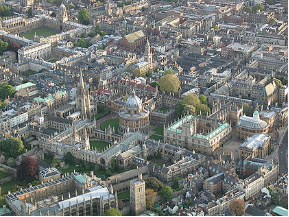
II. Natural Geography (environment and resources)
Location
Oxford's latitude and longitude are 51°45′07″N 1°15′28″WCoordinates: 51°45′07″N 1°15′28″W or grid reference SP513061 (at Carfax Tower, which is usually considered the centre). Oxford is 24 miles (39 km) north-west of Reading, 26 miles (42 km) north-east of Swindon, 36 miles (58 km) east of Cheltenham and 43 miles (69 km) east of Gloucester, 29 miles (47 km) south-west of Milton Keynes, 38 miles (61 km) south-east of Evesham, 43 miles (69 km) south of Rugby and 51 miles (82 km) west-north-west of London.
Climate
Oxford has a maritime temperate climate . Precipitation is uniformly distributed throughout the year and is provided mostly by weather systems that arrive from the Atlantic. The lowest temperature ever recorded in 1860. The highest temperature ever recorded in Oxford is 36.5 °C (98 °F) on 25 July 2019.
Air
In addition to the larger airports in the region, Oxford is served by nearby Oxford Airport, in Kidlington. The airport is also home to CAE Oxford Aviation Academy and Airways Aviation airline pilot flight training centres, and several private jet companies. The airport is also home to Airbus Helicopters UK headquarters.
Buses
Bus services in Oxford and its suburbs are run by the Oxford Bus Company and Stagecoach Oxfordshire as well as other operators including Arriva Shires & Essex and Thames Travel. Arriva Shires & Essex operates Sapphire route 280 to Aylesbury via Wheatley, Thame and Haddenham seven days a week, at a frequency of up to every 20 minutes. The new Sapphire buses have three-pin power sockets, leather seats and free, onboard Wi-Fi.
Rail
In 1844, the Great Western Railway linked Oxford with London Paddington via Didcot and Reading; in 1851, the London and North Western Railway opened its own route from Oxford to London Euston, via Bicester, Bletchley and Watford; and in 1864 a third route, also to Paddington, running via Thame, High Wycombe and Maidenhead, was provided; this was shortened in 1906 by the opening of a direct route between High Wycombe and London Paddington by way of Denham. The distance from Oxford to London was 78 miles (125.5 km) via Bletchley;
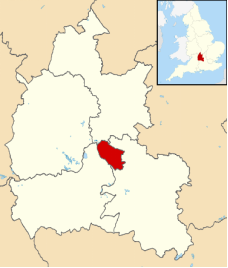
III. Economy
Some key facts about Oxford and the local economy taken from the Fast Growth Cities Report published by Centre for Cities in 2016:
·Oxford has one of the highest Gross Value Added (GVA) per worker in the country at £58,150
·Oxford generates high levels of economy tax per worker and consume low levels of government expenditure
·Oxford is performing particularly well and generating around twice as much in economy taxes as is paid out to them in Government expenditure
·One reason Oxford generates such large economy taxes is our high employment rate
·Oxford has seen the sixth fastest rate of growth out of any UK city
·The strong employment rate has been accompanied by strong private sector jobs growth – 18% in last 5 years
·Oxford is strong in Knowledge Intensive Business Services (KIBS) jobs, which tend to be higher skilled, better paid jobs
·Oxford is one of the Fast Growth Cities that has seen higher business starts than closures over the last ten years
·Oxford is an attractive place to live - over the last 10 years, one of the fastest population growth of any UK city. Oxford experienced annual growth rates of around twice that of the UK. Population of 160,000 – where we were supposed to be in 2021
·This population growth, while an indication of the attractiveness of these cities, places pressure on infrastructure, particularly transport and housing
The OSP has agreed and adopted The Oxford Economic Growth Strategy. It seeks to:
·establish a shared narrative on the future direction of the Oxford economy; and
·define clear strategic priorities, objectives and actions for delivering and managing economic growth in Oxford over the next ten years.
Reference Website:
https://www.payscale.com/research/UK/Location=Norwich-England%3A-Norfolk/Salary
IV. Industrial Characterisitics
Major industries:
1. Car production
Oxford has been an important centre of motor manufacturing since Morris Motors was established in the city in 1910. The principal production site for Mini cars, owned by BMW since 2000, is in the Oxford suburb of Cowley. The plant, which survived the turbulent years of British Leyland in the 1970s and was threatened with closure in the early 1990s, also produced cars under the Austin and Rover brands following the demise of the Morris brand in 1984, although the last Morris-badged car was produced there in 1982.
2. Brewing
There is a long history of brewing in Oxford. Several of the colleges had private breweries, one of which, at Brasenose, survived until 1889. In the 16th century brewing and malting appear to have been the most popular trades in the city. There were breweries in Brewer Street and Paradise Street, near the Castle Mill Stream.
3. Science and technology
The presence of the university has given rise to many science and technology based businesses, including Oxford Instruments, Research Machines and Sophos. The university established Isis Innovation in 1987 to promote technology transfer. The Oxford Science Park was established in 1990, and the Begbroke Science Park, owned by the university, lies north of the city.
Major projects and related introductions:
Tinbergen building
1. Oxford City Council has approved the University’s planning application for the demolition of the existing Tinbergen building along with the enabling works to adjacent and adjoining buildings to allow redevelopment of the site. This follows a public consultation held in May to set out our proposals and invite feedback.
2. The Tinbergen building was the University’s largest teaching and research building before its closure in February 2017 due to the discovery of asbestos throughout the structure and in inaccessible areas. It was not possible to remove this while the building was occupied.
V. Attractions
1. Bodleian Library:
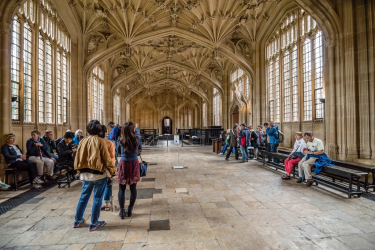
The main research library of the University of Oxford, the Bodleian is one of the oldest libraries in Europe, and without a doubt one of the most beautiful. Sat proudly in Radcliffe Square, it’s one of the city’s most iconic landmarks.
2. University of Oxford Botanic Garden:
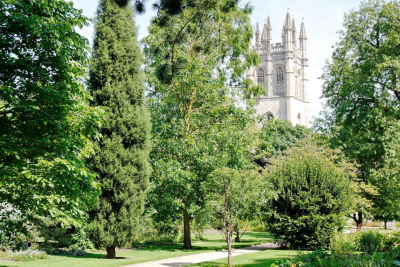
Founded in 1621, the Botanic Garden is a haven of tranquillity in the heart of the city centre. Beautiful herbaceous borders, vibrant glasshouses packed with incredible plants from around the world and colourful flowers make this celebration of nature a must-see.
3. Oxford Castle & Prison:
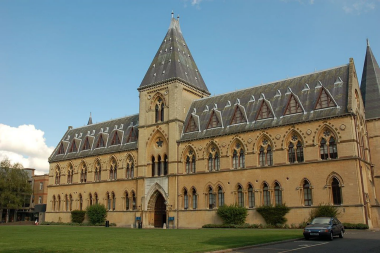
Step back in time with a unique guided tour around Oxford’s historic castle. Costumed characters reveal the interesting history behind the building, plus you have the chance to climb the Saxon St George’s Tower for a stunning 360-degree panoramic view of the city, as well as explore the ancient crypt and prison.
Reference Website:
https://theculturetrip.com/europe/united-kingdom/england/articles/20-must-visit-attractions-in-oxford/
VI. History
Medieval
Oxford was first settled by the Anglo-Saxons and was initially known as Oxnaford, meaning "ford of the oxen", as referenced in Florence of Worcester's Chronicon ex chronicis. A river crossing for oxen began around AD 900. In the 10th century, Oxford became an important military frontier town between the kingdoms of Mercia and Wessex and was raided by Danes. In 1002, many Danes were killed in Oxford during the St. Brice's Day massacre ordered by Æthelred the Unready.
Early modern
In 1790, the Oxford Canal connected the city with Coventry. The Duke's Cut was completed by the Duke of Marlborough in 1789 to link the new canal with the River Thames; and, in 1796, the Oxford Canal company built its own link to the Thames, at Isis Lock. In 1844, the Great Western Railway linked Oxford with London via Didcot and Reading, and other rail routes soon followed. In the 19th century, the controversy surrounding the Oxford Movement in the Anglican Church drew attention to the city as a focus of theological thought. A permanent military presence was established in the city with the completion of Cowley Barracks in 1876.
20th and 21st centuries
During the First World War, the population of Oxford changed. The number of University members was significantly reduced as students, fellows and staff enlisted. Some of their places in college accommodation were taken by soldiers in training. Another reminder of the ongoing war was found in the influx of wounded and disabled soldiers, who were treated in new hospitals housed in buildings such as the university's Examination School, the town hall and Somerville College. By the early 20th century, there was rapid industrial and population growth, with the printing and publishing industries becoming well established by the 1920s. In 1929 the boundaries of the city were extended to include the suburbs of Headington, Cowley and Iffley to the east, and Wolvercote to the north.
VII. Culture
Holywell Music Room is said to be the oldest purpose-built music room in Europe, and hence Britain's first concert hall. Tradition has it that George Frideric Handel performed there, though there is little evidence. Joseph Haydn was awarded an honorary doctorate by Oxford University in 1791, an event commemorated by three concerts of his music at the Sheldonian Theatre, directed by the composer and from which his Symphony No. 92 earned the nickname of the "Oxford" Symphony. Victorian composer Sir John Stainer was organist at Magdalen College and later Professor of Music at the university, and is buried in Holywell Cemetery.
Oxford, and its surrounding towns and villages, have produced many successful bands and musicians in the field of popular music. The most notable Oxford act is Radiohead, who all met at nearby Abingdon School, though other well known local bands include Supergrass, Ride, Swervedriver, Lab 4, Talulah Gosh, the Candyskins, Medal, the Egg, Unbelievable Truth, Hurricane No. 1, Crackout, Goldrush and more recently, Young Knives, Foals, Glass Animals, Dive Dive and Stornoway. These and many other bands from over 30 years of the Oxford music scene's history feature in the documentary film Anyone Can Play Guitar?. In 1997, Oxford played host to Radio 1's Sound City, with acts such as Travis, Bentley Rhythm Ace, Embrace, Spiritualized and DJ Shadow playing in various venues around the city including Oxford Brookes University.
It is also home to several brass bands, notably the City of Oxford Silver Band, founded in 1887.
VIII. Other information
As well as the BBC national radio stations, Oxford and the surrounding area has several local stations, including BBC Oxford, Heart Thames Valley, Destiny 105, Jack FM and Jack FM 2 along with Oxide: Oxford Student Radio (which went on terrestrial radio at 87.7 MHz FM in late May 2005). A local TV station, Six TV: The Oxford Channel, was also available but closed in April 2009; a service operated by That's TV, originally called That's Oxford (now That's Oxfordshire), took to the airwaves in 2015. The city is home to a BBC TV newsroom which produces an opt-out from the main South Today programme broadcast from Southampton.
Popular local papers include The Oxford Times (compact; weekly), its sister papers the Oxford Mail (tabloid; daily) and the Oxford Star (tabloid; free and delivered), and Oxford Journal (tabloid; weekly free pick-up). Oxford is also home to several advertising agencies.
Daily Information (known locally as Daily Info) is an events and advertising news sheet which has been published since 1964 and now provides a connected website.
Nightshift is a monthly local free magazine that has covered the Oxford music scene since 1991.
In 2003 DIY grassroots non-corporate media has begun to spread. Independent and community newspapers include the Jericho Echo and Oxford Prospect.
IX. Contact information
Mayor/Officer: Craig Simmons
Tel: 01865 252414
Mail: dgranito@oxford.gov.uk
